Prikaz osnovnih podataka o dokumentu
Thematic Working Group 5: Formative assessment supported by technology.
| dc.contributor | Kwok‐Wing, Lai | |
| dc.contributor | Joke, Voogt | |
| dc.contributor | Gerald, Knezek | |
| dc.creator | Webb, M. | |
| dc.creator | Andresen, B. | |
| dc.creator | Angeli, C. | |
| dc.creator | Carvalho, A. A. | |
| dc.creator | Dobozy, E. | |
| dc.creator | Laugesen, H. | |
| dc.creator | Kadijević, Đorđe | |
| dc.creator | Phillips, M. | |
| dc.creator | Prasse, D. | |
| dc.creator | Strijker, A. | |
| dc.date.accessioned | 2023-11-25T22:42:03Z | |
| dc.date.available | 2023-11-25T22:42:03Z | |
| dc.date.issued | 2017 | |
| dc.identifier.uri | https://eprints.lancs.ac.uk/id/eprint/89048/1/EDUSummIT_2017_eBook_final.pdf | |
| dc.identifier.uri | http://ipir.ipisr.org.rs/handle/123456789/996 | |
| dc.description.abstract | The future of assessment faces major challenges including the use of IT to facilitate formative assessment that is important for improving learners’ development, motivation and engagement in learning. In many countries, in recent years, a renewed focus on assessments to support learning has been pushing against the burgeoning of testing for accountability, which in some countries, renders effective formative assessment practices almost impossible. Moreover, a systematic review by Harlen and Deakin Crick (2002) revealed that a strong focus on summative assessment for accountability can reduce motivation and disengage many learners. At the same time use of IT‐enabled assessments has been increasing rapidly, as they offer promise of cheaper ways of delivering and marking assessments as well as access to vast amounts of assessment data from which a wide range of judgements might be made about students, teachers, schools and education systems (Gibson & Webb, 2015). These opportunities also extend to assessment of complex collaborative work (Webb & Gibson, 2015). Current opportunities for using IT, including for harnessing the data that is being collected automatically, for formative assessment are underexplored and less well understood than those for summative assessments. Opportunities for learning with IT and perhaps with less teacher input are increasing but this depends on students developing as autonomous or independent learners. Research in formative assessment including effective feedback has emphasised the value of peer assessment practices for developing self‐assessment capabilities and hence independent learners (Black, Harrison, Lee, Marshall, & William, 2003). At previous EDUsummITs the possibilities and challenges for IT‐enabled assessments to support simultaneously both formative and summative purposes were analysed (Webb, Gibson, & Forkosh‐Baruch, 2013). While these challenges remain, at EDUsummIT 2017 we focused on the opportunities and challenges of IT supporting formative assessment because effective formative assessment is known to be extremely important for learning. | sr |
| dc.language.iso | en | sr |
| dc.rights | openAccess | sr |
| dc.source | Rethinking learning in a digital age | sr |
| dc.title | Thematic Working Group 5: Formative assessment supported by technology. | sr |
| dc.type | conferenceObject | sr |
| dc.rights.license | ARR | sr |
| dc.citation.epage | 53 | |
| dc.citation.spage | 46 | |
| dc.description.other | RETHINKING LEARNING IN A DIGITAL AGE, EDUsummIT 2017 Summary Reports 18-20 september, Bulgaria | sr |
| dc.identifier.fulltext | http://ipir.ipisr.org.rs/bitstream/id/3106/EDUSummIT_2017_eBook_final_1-4,46-53,84.pdf | |
| dc.identifier.rcub | https://hdl.handle.net/21.15107/rcub_ipir_996 | |
| dc.type.version | publishedVersion | sr |

